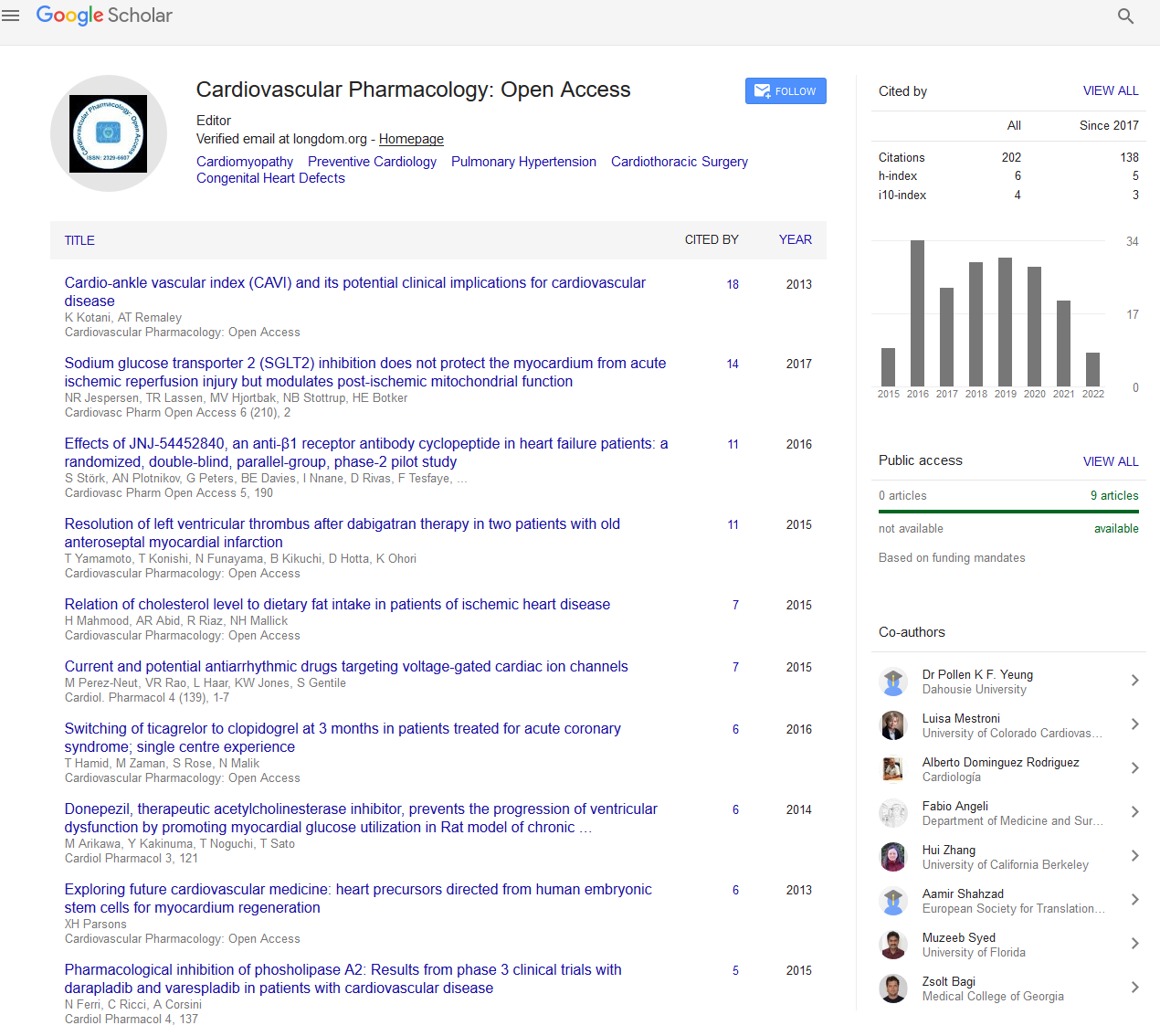Indexed In
- Open J Gate
- Cosmos IF
- RefSeek
- Hamdard University
- EBSCO A-Z
- OCLC- WorldCat
- Publons
- Geneva Foundation for Medical Education and Research
- Euro Pub
- Google Scholar
Useful Links
Share This Page
Journal Flyer

Open Access Journals
- Agri and Aquaculture
- Biochemistry
- Bioinformatics & Systems Biology
- Business & Management
- Chemistry
- Clinical Sciences
- Engineering
- Food & Nutrition
- General Science
- Genetics & Molecular Biology
- Immunology & Microbiology
- Medical Sciences
- Neuroscience & Psychology
- Nursing & Health Care
- Pharmaceutical Sciences
Commentary - (2023) Volume 12, Issue 2
Thermodynamic Analysis of Cardiovascular System in Human Body
Garland Najaman*Received: 03-Mar-2023, Manuscript No. CPO-23-20521 ; Editor assigned: 06-Mar-2023, Pre QC No. CPO-23-20521 (PQ); Reviewed: 20-Mar-2023, QC No. CPO-23-20521; Revised: 27-Mar-2023, Manuscript No. CPO-23-20521 (R); Published: 03-Apr-2023, DOI: 10.35248/2329-6607.23.12.338
Description
The present work is concerned with human cardiovascular system. The cardiovascular system is responsible for transport of blood along with nutrients, gas, enzymes, metabolic waste etc. throughout the body. It also delivers O2 and CO2 between the two terminal sections i.e. alveolar air and cell. The system consists of heart, lung, blood vessels and blood. Each component of the system is designated for a particular task to achieve the goal of the system.
The function of the heart is very similar to the mechanical pump, which is to circulate blood through the entire body. The oxygenation and de-carboxygenation is taken care by the lung, the blood vessels are the network for sending blood to the whole body and the function of the blood is to carry nutrients, gas, enzymes, metabolic waste etc. with itself. The source of energy for the operation of the cardiovascular system is metabolism.
The heart is an important organ of the cardiovascular system which pumps the blood through the blood vessels. It is divided into two compartments namely the left side of the heart and the right side of the heart. These two portions of the heart, acts as two separate pumps. These are connected with the two individual circulatory system i.e. systemic circulation and pulmonary circulation. It can be observed that the right portion of the heart receives blood through the vena cava and circulated it in the pulmonary circulation. In the pulmonary circulation, the blood gets oxygenated and de-carboxygenated in the lung capillary. The oxygenated blood now entered into the right heart through the pulmonary vein and pumped out through the aorta to circulate in the systemic circulation. Each side of the heart has two chambers, the atrium and the ventricle. They are periodically contract and relax. The contraction and relaxation are known as, systole and diastole, respectively. The systole and diastole of the atria and the ventricles are synchronized in such a fashion that when the atria are contracting the ventricles are relaxed, and viceversa. The atrium receives and stores blood during the ventricular contraction, and blood flows from the atrium to the ventricle during ventricular relaxation. The cardiovascular system plays a vital role in the body by ensuring the circulation of blood and the transportation of nutrients, gases, enzymes, metabolic waste, etc., throughout the body. The cardiovascular system, also known as the circulatory system, is responsible for the transportation of blood and oxygen throughout the body. This intricate network of arteries, veins, and capillaries is regulated by the principles of thermodynamics. In this article, we will explore the thermodynamic analysis of the cardiovascular system in the human body. Thermodynamics is the branch of physics that deals with the relationship between heat, work, and energy. It is a fundamental principle of the natural world and is used to explain many physical phenomena. In the case of the cardiovascular system, thermodynamics plays a critical role in understanding the movement of blood and the regulation of blood pressure. The first law of thermodynamics, also known as the law of conservation of energy, states that energy cannot be created or destroyed, only transferred or converted from one form to another. In the case of the cardiovascular system, this law applies to the transfer of energy from the heart to the blood and the subsequent transfer of energy from the blood to the tissues. The heart is the primary source of energy in the cardiovascular system. It is responsible for pumping blood throughout the body, which requires a significant amount of energy. The heart muscle itself requires energy to function, which is provided by the breakdown of glucose and other molecules. The energy required to pump blood is transferred to the blood in the form of pressure. Blood pressure is the force that blood exerts on the walls of blood vessels as it moves through the body.
Blood pressure is regulated by the second law of thermodynamics, which states that in any process, the entropy of the universe increases. In the case of the cardiovascular system, this means that the movement of blood through the body is driven by a decrease in the entropy of the blood. The movement of blood through the body is a complex process that is driven by a combination of pressure gradients and the contraction of smooth muscle in the walls of blood vessels. Blood flows from areas of high pressure to areas of low pressure, which is why the heart pumps blood from the left ventricle to the aorta, which then branches out into smaller and smaller vessels throughout the body.
Citation: Najaman G (2023) Thermodynamic Analysis of Cardiovascular System in Human Body. Cardiovasc Pharm. 12:338.
Copyright: © 2023 Najaman G. This is an open access article distributed under the terms of the Creative Commons Attribution License, which permits unrestricted use, distribution, and reproduction in any medium, provided the original author and source are credited.


